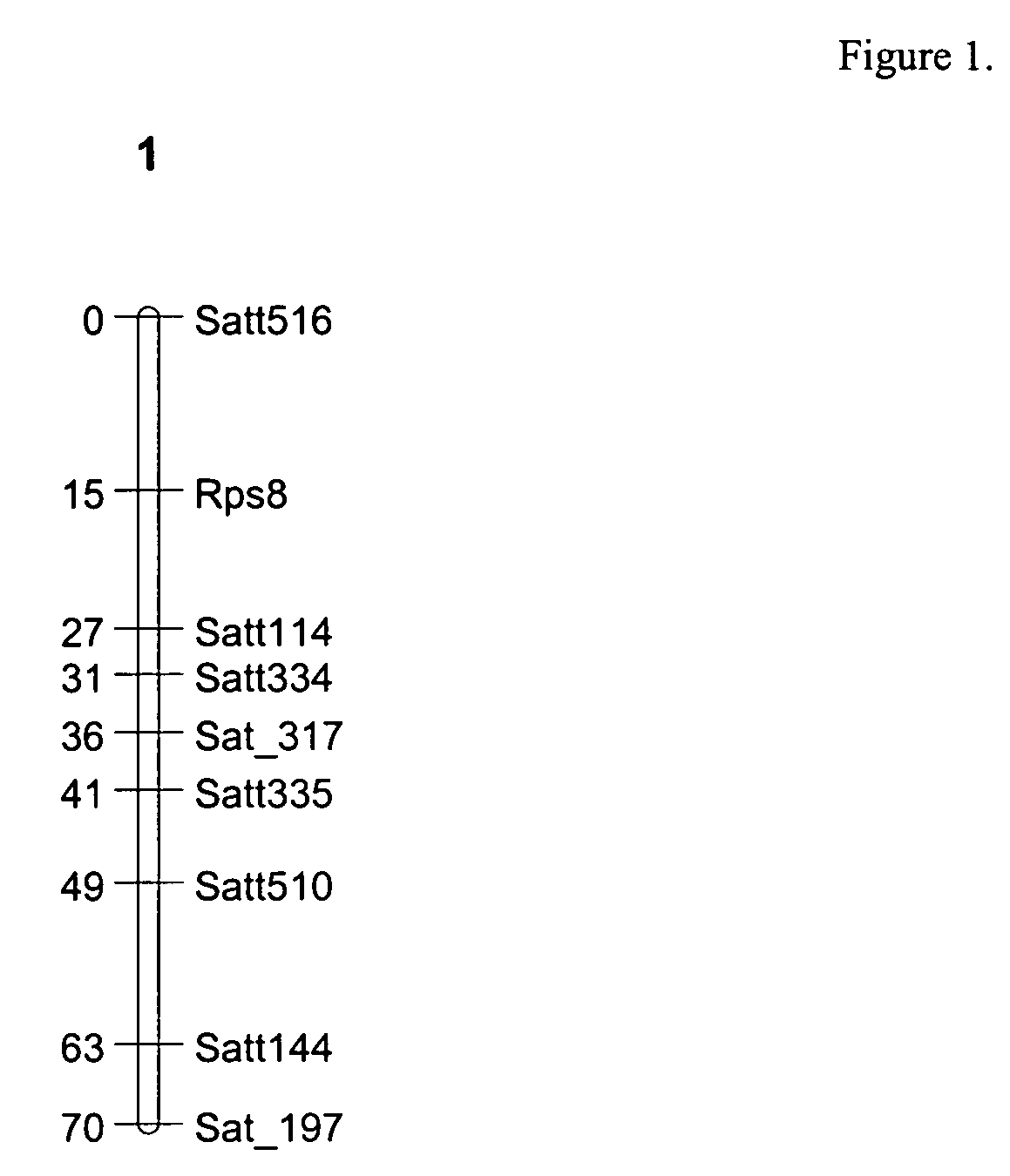Identification of soybeans having resistance to Phytophthora sojae
a technology of phytophthora sojae and soybeans, which is applied in the field of soybean plants, can solve problems such as yield loss, and achieve the effect of confirmating the selection of phytophthora resistan
- Summary
- Abstract
- Description
- Claims
- Application Information
AI Technical Summary
Benefits of technology
Problems solved by technology
Method used
Image
Examples
example 1
Phenotypic Evaluation of Rps8-derived Phytophthora sojae Resistance
[0068]Korean plant introductions (PI399073) were obtained from the USDA Soybean Germplasm Collection in Urbana, Ill. All other plant material was obtained from the Ohio Agricultural Research Development Center (OARDC) soybean breeding program. The crosses used for mapping the new Rps8 allele were Williams (rps) X PI399073, S 19-90 (Rps1c) X PI399073, and Williams (rps) X PI399073. The F1 plants from these crosses were selfed to produce populations of approximately 40 to 60 and 143 F2 plants for each cross. The F2 plants were then selfed and each plant was thrashed individually to yield seed for F2:3 families.
[0069]Isolates of P. sojae pathotypes were maintained at the Department of Plant Pathology, OARDC. All pathotypes used in this study were collected in Ohio. Three isolates of P. sojae were used in this study with the following pathotypes OH1 (vir 7), OH17 (vir 1b, 1d, 3a, 3b, 3c, 4, 5, 6, 7), and OH25 (vir 1a, 1b...
example 2
[0075]Simple Sequence Repeat (SSR) DNA Length Polymorphism Markers Indicating Association of SSR markers Satt595, Satt114, Satt334, Sat—317, Sat 197, Satt510, Satt335 and Satt144 with Phytophthora sojae Resistance in PI399073, thus Placing the Novel Trait Locus for Rps8 on Major Linkage Group (MLG) F.
[0076]The cross used for analyzing SSR marker association was Williams (Rps) X PI 399073. The F1 plants from this cross were selfed to produce a population of approximately 150 F2 plants. The F2 plants were then selfed and each plant was thrashed individually to yield seed for F2:3 families.
[0077]Whole plants from individual F3 seedlings were bulked from each F2:3 family, and DNA was extracted as previously described (Saghai-Maroof et al., 1984). SSR primer pairs (Research Genetics Inc., Huntsville, Ala.), polymorphic for the parents in each cross, were used to test the F2:3 progeny. PCR reactions were performed as recommended by the manufacturers in a total of 20 μl containing 30 ng of...
example 4
Linkage Map of MLG F of Soybean, Using SSR Markers, Providing Placement of Novel Trait Locus for Rps8 in Relation to Rps1-Rps7 on the Composite Soybean Genetic Map
[0082]The crosses used for mapping the new allele were Williams (Rps) X PI399073 and S 19-90 (Rps1c) X PI399073. The F1 plants from these crosses were selfed to produce populations of approximately 150 and 60 F2 plants for each cross, respectively. The F2 plants were then selfed and each plant was thrashed individually to yield seed for F2:3 families.
[0083]Analysis with SSR markers was performed as previously described.
[0084]Chi-square analysis was used for each DNA marker to test whether the F2:3 families fit the expected 1:2:1 ratio. DNA marker data that fit the expected ratio was then used in an ANOVA to determine if the marker data was significantly associated with resistance. ANOVAs were conducted using the GLM procedure in SAS (SAS institute, 1988). Once an SSR marker was found that was significantly associated with ...
PUM
| Property | Measurement | Unit |
|---|---|---|
| Tm | aaaaa | aaaaa |
| Tm | aaaaa | aaaaa |
| Tm | aaaaa | aaaaa |
Abstract
Description
Claims
Application Information
 Login to View More
Login to View More - R&D
- Intellectual Property
- Life Sciences
- Materials
- Tech Scout
- Unparalleled Data Quality
- Higher Quality Content
- 60% Fewer Hallucinations
Browse by: Latest US Patents, China's latest patents, Technical Efficacy Thesaurus, Application Domain, Technology Topic, Popular Technical Reports.
© 2025 PatSnap. All rights reserved.Legal|Privacy policy|Modern Slavery Act Transparency Statement|Sitemap|About US| Contact US: help@patsnap.com

